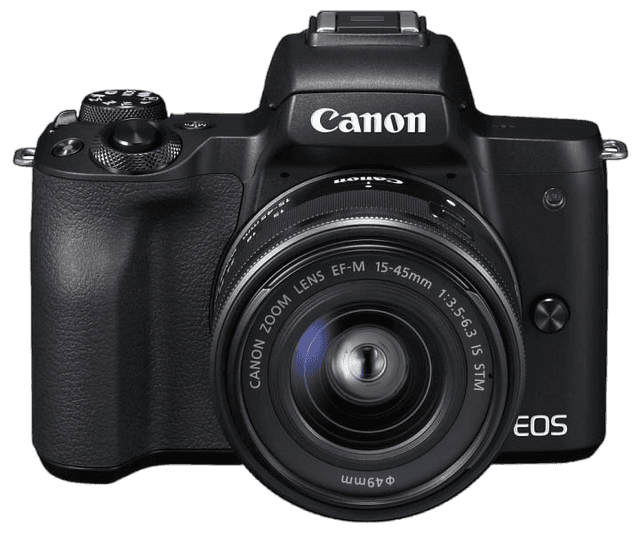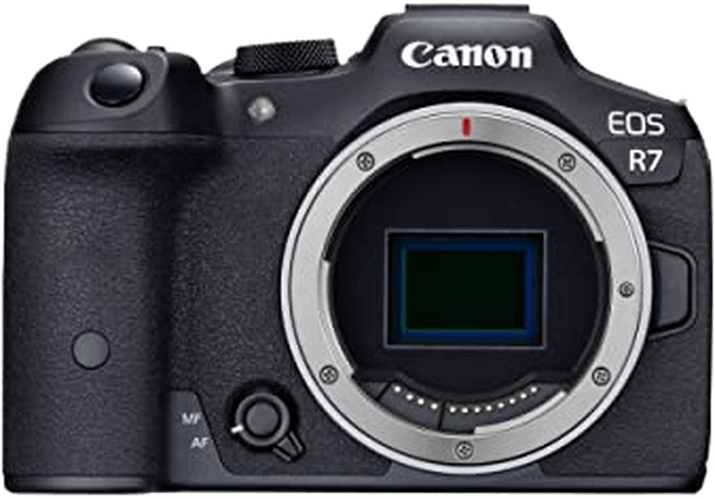Canon EOS M50 vs EOS R7 Comparison
Canon EOS M50

Canon EOS R7

The Canon EOS R7 outperforms the Canon EOS M50 with a score of 83/100 compared to 59/100. Both cameras share similarities, such as being mirrorless and having similar dimensions. However, the EOS R7, released in 2022, is a newer model with a higher launch price of $1500, while the EOS M50 was released in 2018 at a price of $779.
The EOS R7 excels with its higher score, reflecting its superior performance and features. On the other hand, the EOS M50 has a lighter weight of 390g compared to the EOS R7’s 612g, making it easier to carry around.
Taking these factors into account, the Canon EOS R7 proves to be a better camera in terms of performance and features, while the EOS M50 is more suitable for those prioritizing a lighter and more affordable option.
Canon EOS M50 vs EOS R7 Overview and Optics
The Canon EOS R7 emerges as the winner in the optics comparison with a score of 82/100, outperforming the Canon EOS M50, which scored 59/100. Both cameras share similarities in their specifications, such as having CMOS sensors, APS-C sensor sizes, and being equipped with Canon’s proprietary lens mounts – the EOS M50 with EF-M and the EOS R7 with RF.
The EOS R7’s superiority in optics can be attributed to several key factors. Firstly, it has a higher megapixel count of 33 compared to the EOS M50’s 24, allowing for more detailed and higher resolution images. Secondly, the EOS R7 boasts a faster shooting speed of 15 frames per second (fps), compared to the EOS M50’s 10 fps, enabling better capture of fast-moving subjects. Furthermore, the EOS R7 features a more advanced processor, the Digic X, compared to the EOS M50’s Digic 8, resulting in better image processing and performance. Lastly, the EOS R7’s sensor has a significantly higher DXOMARK score of 97, compared to the EOS M50’s 58, and also includes image stabilization, which the EOS M50 lacks.
On the other hand, the EOS M50 has a few advantages. It is more affordable and lightweight, making it a more accessible option for entry-level photographers and those prioritizing portability.
Taking all these factors into account, the Canon EOS R7 is the better choice for those seeking superior optics and performance, particularly for capturing high-quality, detailed images and fast-moving subjects. Meanwhile, the Canon EOS M50 serves as a more budget-friendly and portable option, suitable for beginners or those with less demanding requirements.
Canon EOS M50 vs EOS R7 Video Performance
The Canon EOS M50 and Canon EOS R7 are tied in video capabilities, both receiving a score of 91/100. These cameras share several key specifications, making them competitive options for videographers.
Both the EOS M50 and EOS R7 offer 4K video resolution, with maximum dimensions of 3840 x 2160 pixels. This high resolution ensures clear and detailed video footage. Additionally, each camera has a maximum video frame rate of 120fps, enabling smooth slow-motion recording. Another common feature is the built-in time-lapse functionality, which allows users to create captivating time-lapse videos without the need for additional software or accessories.
While both cameras have impressive video capabilities, there may be areas where one camera excels over the other. For instance, the EOS M50 might offer better video autofocus, image stabilization, or color reproduction. These factors could contribute to its high score and make it an appealing choice for certain videographers.
On the other hand, the EOS R7 may have advantages in other areas, such as improved low-light performance, longer battery life, or more robust weather sealing. These factors could also contribute to its high score, making it a suitable option for different types of video projects.
In comparing the Canon EOS M50 and Canon EOS R7, it is clear that both cameras have strong video capabilities. With identical scores of 91/100 and shared key specifications, users can expect high-quality video performance from either camera. Potential differences in autofocus, image stabilization, and low-light performance may sway videographers toward one camera over the other. Ultimately, the choice will depend on individual preferences and specific project requirements.
Canon EOS M50 vs EOS R7 Features and Benefits
The Canon EOS R7 outperforms the Canon EOS M50 with a feature score of 85/100 compared to 70/100. Both cameras share several specifications, including a 3-inch screen size, touchscreen functionality, flip screen, GPS absence, WIFI, and Bluetooth connectivity.
The EOS R7 excels with its higher screen resolution of 1,620,000 dots, compared to the M50’s 1,040,000 dots. This higher resolution provides clearer and more detailed image previews and better menu navigation. The R7’s advantage in this aspect contributes to its higher feature score and makes it a superior option for photographers who value image quality and ease of use.
The EOS M50, despite its lower feature score, still offers useful capabilities. Its touchscreen and flip screen make it convenient for capturing images and videos from various angles, and its WIFI and Bluetooth connectivity enable easy sharing and remote control. However, it falls short in comparison to the R7’s superior screen resolution.
In evaluating these cameras, the Canon EOS R7 emerges as the better option due to its higher feature score and improved screen resolution. The EOS M50 remains a viable choice for those seeking a camera with standard features and connectivity options but may not satisfy users who prioritize image quality and detail. The EOS R7’s advantages make it the preferable choice for photographers seeking a more advanced and capable camera.
Canon EOS M50 vs EOS R7 Storage and Battery
The Canon EOS R7 outperforms the Canon EOS M50 in storage and battery with a score of 79/100, while the M50 scores only 13/100. Both cameras accept SD, SDHC, and SDXC memory cards, but the R7 is UHS-II compatible, offering faster read and write speeds. Additionally, the R7 has two memory card slots, providing more storage capacity and flexibility, compared to the M50’s single slot.
The R7 also has a longer battery life, capable of capturing 660 shots on a single charge, whereas the M50 is limited to 235 shots. The R7 uses the LP-E6NH battery type and supports USB charging, which the M50, with its LP-E12 battery, lacks.
Despite these differences, the M50 has no advantages over the R7 in storage and battery. The R7 clearly excels in both areas, making it a better choice for photographers who require longer shooting sessions and increased storage options.
Canon EOS M50 vs EOS R7 – Our Verdict
Are you still undecided about which camera is right for you? Have a look at these popular comparisons that feature the Canon EOS M50 or the Canon EOS R7:

